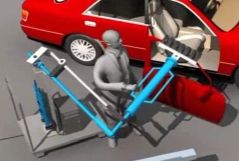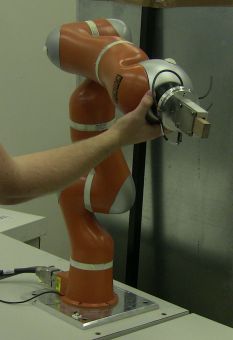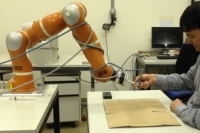| Human Intent Detection in Physical Interaction with Robot Nawaaz+Sidharth+ GUJJA+SHAIK (CH) Physical human-robot interaction (pHRI) takes place by the touch of the human on the rigid body of the robot. Typically human pushes and pulls on the robot in order to reposition it in a desired way. However, it is a tricky question how to distinguish a human impact from an ordinary external disturbance or a change in load. The force measurements of impulsive human impact reveal that the human applies a smoothly changing bell shaped force profile. The knowledge of such profile might be used to distinguish human impact from a sudden external impact due to rigid collision or change in load. In this project the researcher will develop a signal recognition scheme in order to distinguish human push-pull impact from hard collision and load change. The implementation will be with the KUKA LWR robot in C++ environment. (References: Erden, M.S. and Tomiyama, T., 2010. “Human intent detection and physically-interactive control of a robot without force sensors”, IEEE Transactions on Robotics, 26(2): 370-382; Erden, M.S. and Jonkman, J.A., 2012. “Physical human-robot interaction by observing actuator currents”. International Journal of Robotics and Automation, vol. 27 (3): 233-243. Please do not hesitate to ask for the papers.) Project: Semester Project Period: 01.01.2013 – 25.01.2014 Section(s): EL IN ME MT Type: 30% theory, 35% software, 35% hardware Knowledge(s): C++ Subject(s): Robotics Responsible(s): Mustafa Suphi Erden, Lucia Pais Ureche |  |
| Physical Human-Robot Interaction without Force Sensor Riccardo Formenti (MT) Physical human-robot interaction (pHRI) takes place by the touch of the human on the rigid body of the robot. Typically human pushes and pulls on the robot in order to reposition it in a desired way. The human impact is mostly sensed by force or touch sensors. However, such sensors are expensive. Therefore, despite the existence of many robotic toys and affordable research robots (e.g. Nao robot) in the market, such robots are not equipped with pHRI schemes. Is it possible to achieve pHRI without force sensors? Can we provide a means of pHRI for affordable robots? In a recent paper the proposer developed a control scheme which would serve for this idea. The purpose of this project is to demonstrate that this control scheme is implementable with a conventional robot like the KUKA LWR. (References: Erden, M.S. and Tomiyama, T., 2010. “Human intent detection and physically-interactive control of a robot without force sensors”, IEEE Transactions on Robotics, 26(2): 370-382; Erden, M.S. and Jonkman, J.A., 2012. “Physical human-robot interaction by observing actuator currents”. International Journal of Robotics and Automation, vol. 27 (3): 233-243. Please do not hesitate to ask for the papers.) Project: Semester Project Period: 01.01.2013 – 25.01.2014 Section(s): EL IN ME MT Type: 25% theory, 45% software, 30% hardware Knowledge(s): C++ Subject(s): Robotics Responsible(s): Mustafa Suphi Erden, Hang Yin |  |
| Identifying the Bandwidth of the KUKA LWR Robot J%E9r%E9mie+ Jaccard (MT) The “bandwidth” of a robot refers to how fast the robot can respond to the commands send by the controlling computer. This bandwidth is especially important for physical human-robot interaction applications. When the bandwidth is small, the position change of the robot due to the impact by human is delayed. This results, for example, in oscillatory behaviors when the human stiffens the robot. The best is to have as large bandwidth as possible; however, there is always a limit on that due to the limited communication rate between the robot and the controller as well as the mechanical structure of the robot. Although the KUKA LWR is a widely used robot in research, surprisingly, there is yet no rigorous study on its bandwidth. This project aims to address this need and measure the bandwidth of the KUKA LWR. Bandwidth measurement concerns applying sinusoidal commands in different frequencies and measuring the phase and magnitude of the response by the robot. There is great chance that a successful project in this topic might get published in some conferences and might attract significant attention. For a sample study for another robot you might refer to the following reference. (Reference: R. Q. van der Linde, P. Lammertse, E. Frederiksen, and B. Ruiter, “The HapticMaster, a new high-performance haptic interface,” in Proc. Euro-Haptics Conf., Edinburgh, U.K., 2002, pp. 1–5.) Project: Semester Project Period: 01.01.2013 – 01.01.2014 Section(s): EL IN ME MT Type: 20% theory, 40% software, 40% hardware Knowledge(s): C++ Subject(s): Robotics Responsible(s): Mustafa Suphi Erden |  |